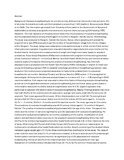| dc.description.abstract | Background: Exclusive breastfeeding for six months is a key child survival intervention
that prevents 13% of all under-five deaths annually and this translates to preventing
11,000 deaths in Kenya annually (Black et al, 2008). The information generated from this
study will be useful to the Government of Kenya and stakeholders to develop area
specific interventions to improve infant and young child feeding (IYCF).
Objective: The main objective of this study was to determine the prevalence of exclusive
breastfeeding and the associated factors among infants aged 0–6 months in Kangemi,
Nairobi County.
Methodology: The study was conducted in Kangemi, Nairobi City County, Kenya, where
sampling with probability proportional to size (PPS) was used to get the number of
households per village from the ten villages within Kangemi. The study design was a
descriptive cross-sectional study in which a total of 334 mother-infant pairs were
sampled. A questionnaire was administered to respondents who were mothers of the
studied infants. Anthropometric measurements of weight and height were taken based on
standard procedures. Focus Group Discussions (FGDs) were conducted with pregnant
mothers during antenatal clinics, mothers of infants 0 – 6 months at Mother and Child
Health (MCH) clinics, and mothers at labour wards to explore the factors influencing the
practice of exclusive breastfeeding. Key informant discussions were conducted with five
Health Care Providers (HCPs) individually in relation to infant and young child feeding
practices (IYCF) to establish knowledge and skills on breastfeeding practices. Case
studies on five mothers were conducted separately on factors that enabled them to
exclusively breastfeed for six months. Statistical Product and Service Solution (SPSS
version 17.0) was applied for data analysis. Anthropometric data was analyzed based on a
z-score of ≥ -2 or < -3 SD according to WHO recommendations. A chi-square test was
used to determine factors influencing exclusive breastfeeding as well as to find
associations between exclusive breastfeeding and nutritional status, growth pattern,
immunization status and morbidity status at a significance level of 0.05. Logistic
regression was performed to ascertain the determinants of exclusive breastfeeding.
Results: Findings showed that more than half (55.8%) of the mothers were 25 years old
or younger and nearly a half (44.2%) were over 25 years old. Their mean age was 25±4.4
years. Of the infants studied, over a half (52.7%) were girls and almost a half (47.3%)
xiv
were boys. Nearly one-third of the infants (32.5%) were aged 3 – 4 months, 30.7% 1 – 2
months, 26.8% 5 – 6 months and 9.3% less than month. The mean age was 3±1.8 months.
The prevalence of exclusive breastfeeding was 45.5% among infants aged 0 – 6 months
in Kangemi, Nairobi. The practice of exclusive breastfeeding decreased with the age of
the infant. The ages of the infant and the mother-in-law were significantly (p<0.05)
associated with exclusive breastfeeding. For mothers who exclusively breastfed for six
months, availability of the mother, modification of work pattern and self-determination
were key to the success of exclusive breastfeeding. More than half (54.5%) of the
mothers had supplemented other feeds/fluids with breast milk to their infants at the time
of study. Child crying (36.5%) and child thirsty/hungry (34.5%) were the common
reasons given by mothers who introduced other feeds/fluids before six months. Growth
monitoring of the studied infants indicated a good weight gain (73.1%) for those
monitored three months prior to the study. The rates of under nutrition were low where
3.1% of infants were wasted, 9.3% were stunted and 4.5% underweight. Growth pattern
and stunting were found to be significantly (p<0.05) associated with exclusive
breastfeeding. Almost all (93.3%) of the infants had been immunized completely for their
age. Assessment of morbidity status indicated diarrhoea (22.1%) to be the common
illness experienced by infants two weeks prior to the study. At the health facility, the
infant and young child feeding policy and self-assessment tool on the BFHI were
available. Nearly a third (32%) of health care providers were trained on IYCF and Baby
Friendly Hospital initiative (BFHI.)
Conclusion and recommendations: The prevalence of exclusive breastfeeding was
45.5% which was higher compared to the national level of 32% and to those found in
other studies. Strengthening of factors that enable mothers to exclusively breastfeed for
six months can contribute to achieving the national target set out in the Maternal Infant &
Youth Child Nutrition (MIYCN) strategy of increasing exclusive breast feeding rates
from the current 32% to 80% by 2017. | en |


